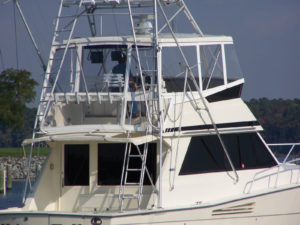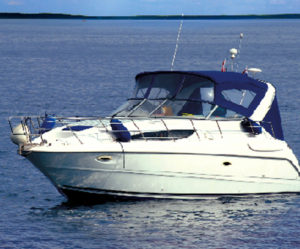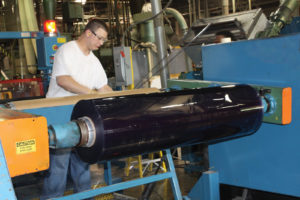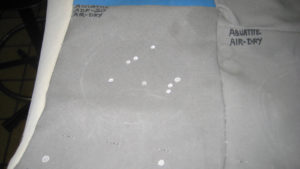Fabric technology

This enclosure is made of Herculite Riviera Marine fabric – Herculite’s new exterior vinyl textile. It was developed to meet market demand for waterproof enclosures to protect climate controlled areas on larger boats. Photo: Canvas Experts, Ocean City, Md.
Life in 21st century United States is dominated by technology—new technologies, as well as updates, upgrades and changes to the already familiar. We have smart phones and smarter cars, genetically modified food and DNA analysis in law enforcement. Although it may seem that these changes happened in an instant, technology actually advances in small steps.
Technological change is driven by the need for better use-value on the end (the product) and lower costs in production (the process). Manufacturers in the marine market upgrade their products and production processes to meet the demands of boat owners and those that serve them. For example, the expectations boat owners have for their boat covers have grown beyond merely protecting their boats. They want the covers looking as good as possible for as long as possible with longer color and form retention, and simple, easy maintenance. Manufacturers of marine materials respond with improved products to meet the market demands.
New ideas
Innovation in marine fabric manufacturing may originate in a company’s research laboratory, it may result from business mergers that streamline the production process, it may happen when an existing product or process is applied in a new way. Inspiration for change often comes from the market.

Fabrics don’t get reinvented very often, Innovation creates improvements to fabrics and other products. The improvements are carefully developed, researched and tested before being introduced to the market.
“Ideas for new products and technologies come directly from product end users and our distributors,” says Craig Zola, business manager, awning and marine, at Herculite Products Inc. “Occasionally, a new product solution is developed on one side of Herculite’s six market divisions and that same technology is used in the development of a new solution in a different market.” Zola described an edge-curling resistant base fabric scrim construction that Herculite originally developed for the European window shade market. He said that fabric, “was brought over to our Bantex digital fabric division and an edge-curl resistant pop-up banner fabric was developed.”
Improvements can take place at any step along the production process and don’t necessarily create an entirely new fabric.
“Fabrics don’t get reinvented very often, rather, innovation creates improvements to fabrics and other products,” says Jeff Jimison, vice president of sales for marine, awning and international at Shuford Mills. “And these improvements are carefully developed, researched and tested before being introduced to the market.”
Steven Weiss, national sales manager at Sattler North America, explained that it generally takes about three years to bring a new product to market. “It takes one year just to introduce it, the second year marketing it, then getting people to use it in the third year,” he says.
David Manning, president and CEO of Sattler North America, says, “We’ll come up with an idea and check it out as far as its utilitarian value. Once it’s developed, we test it extensively for probably one to two years of accelerated aging and so on before we ever bring it to market. And then it goes through the cycle.”
Sometimes, product innovation grows out of the manufacturer’s internal business structure. For example, Glen Raven is a vertically integrated company. “And because of that,” Vince Hankins, industrial business manager at Glen Raven says, “we control every step of the manufacturing process, from the time the raw fiber hits our doorstep, until the finished fabric leaves our facility.” Hankins says the benefits from the vertical structure track all the way through “the interaction we have with our finish-formulation partners, the formulating chemists that we work with, and our vendors to develop the optimum recipe, if you will, of finishes to deliver the performance attributes of the fabric. All those steps are being undertaken over a period of several years as we continuously try to improve and enhance the performance of the brand.”
As a result of this process, Glen Raven was able to increase the warranty period on its flagship fabric from five to 10 years. Hankins points out that the improved appearance and durability is the result of many small enhancements, technologies and business structure changes. “It was in conjunction with the improvements that were made with the strength of the fabric, with the color integrity, with the color retention of the product,” he says. “We were given the confidence to say ‘OK, let’s take this major step for an industry leading warranty.’”
Innovation

A low-cohesion additive developed by TMI is inherent to the PVC compound in Save-T PVC. The low-cohesive qualities make the vinyl easier to work with and store, without compromising the high level of clarity. Photo: TMI LLC.
Other times, the new product is the result of innovation—of using an existing technology in a new application. Shuford Mills partnered with a company that makes protective garments for the medical industry to produce a three-layer laminated fabric for the marine industry. The fabric was originally intended for clothing that would prevent dangerous fluids from penetrating the fabric, while allowing perspiration to evaporate and keep the wearer comfortable. “The real magic is the middle fabric, which is not actually a fabric, but film,” Jimison says. “It uses a microporous membrane technology. Water droplets are too large to penetrate those micropores but the water vapor can escape.” The result is a marine fabric designed for boat covers that is both waterproof and breathable.
Another solution to the marketplace demand of waterproof and breathable cover fabric was developed at SattlerAG. Its breakthrough was the development of a special patented coating that’s applied to the back of a woven acrylic fabric. Weiss describes its benefit to the boat owner and to fabricators: “What’s nice about it is there’s no venting involved. People can fit a cover with no vents and as soon as the water hits it, it reacts with the coating and becomes 100-percent waterproof. When it stops raining, it opens up to let the heat pass through it. Now it’s breathable and there’s no condensation from the cover that’s dripping on the floor, or that’s dripping on the cushions, on the helm, or on the seats. It eliminates a lot of mold and moisture issues.”
Making change

MarChem CFI developed Aqua-tite, a treatment that restores water repellency to fabric. Aqua-tite is very low in volatile organic compounds ( VOC ) and is safe to use near bodies of water. The photo shows water beading up on a test panel of treated fabric. Photo: MarChem CFI.
Alan Prelutsky, vice president of sales and marketing at DASH Multi-Corp/MarChem CFI says there are two prongs to new product development. “There’s improving the current product where you’re not making a new product but you’re tweaking the current product to keep manufacturing costs down,” he says. “And other times, it’s to solve problems that are out there in the marketplace.” For example, inexpensive imports from Asia have increased the competitive pressure on U.S. manufacturers to reduce costs, use resources more efficiently and find new ways to use already existent techniques.
Ultimately, the best way to maintain market share is to meet increasingly specific customer demands by trying to stay ahead of the competition. For example, fabricators know that coated fabrics have had a tendency to crock, for the color to rub off or bleed onto gel coat and vinyl upholstery. Improvements developed at MarChem over the last five years targeted this problem. “We haven’t come out with a brand new product, but we changed the chemical formulation of the coating,” Prelutsky says. “And all that has resulted in a fabric that has much less crocking.”
Technological change in the production process for clear vinyl at TMI LLC has improved its marine vinyl. In order to improve a vinyl’s clarity, it must be made smoother. But making it smoother makes it stickier. The little hills and valleys that impede clarity keep the vinyl from sticking to itself. In order to solve this, TMI founder and consultant, Joseph Kleynjans says, “We have formulated a very special compound that includes a low-cohesion additive, meaning it’s a lot easier to move the vinyl over the table of the sewing machine. When you fold up the unit, it won’t stick to itself.” The low-cohesion, high clarity, cold-crack, scratch- and UV-resistant vinyl has been in the market for about three years. Fabricator feedback has been positive, Kleynjans says, “because it’s easy to work with and a single fabricator can produce a window or a top without having to have a second person at the cutting table.”
Getting the word out
New products and new product information flow back to the market along the same network of distributors and fabricators that originally told the manufacturers about their needs. New product information is rolled out to the sales force, then the distributor networks, and finally to the fabricators. Manufacturers may present educational sessions for fabricators at industry conferences and promote their new product directly to the boat-owning public through articles, advertising and boat shows.
MarChem uses new technologies to roll out new products. “First thing we’ll do is train our distributors,” Prelutsky says. “We use WebEx, a web-based seminar, and train our distributors so they can go out to the end-user and educate them.”
New fabrics. New materials. New accessories. The marine market can be baffling. It’s hard for fabricators to decide which materials to recommend when they’re in the middle of negotiating a big job. It may be even more difficult for the marine materials manufacturer. Fabricators take risks by trying something new. Manufacturers gamble years developing a new coating, a new laminating process, a new fabric treatment to bring new products to the market—and make the jobs of marine fabricators easier.
Mary Jo Morris previously owned and operated Berkeley Marine Canvas in Berkeley, Calif. She and her husband, Jim, live in Point Richmond, Calif., and sail on San Francisco Bay.
 TEXTILES.ORG
TEXTILES.ORG 






